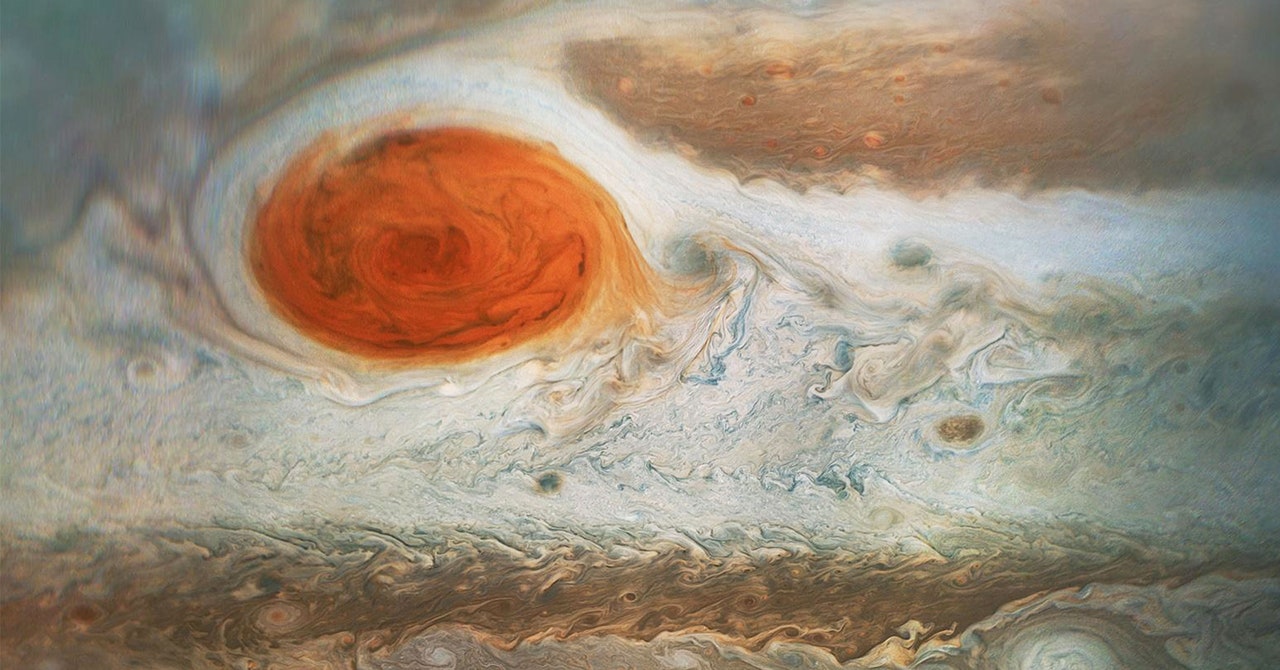
The Great Red Spot—the iconic, swirling eye of Jupiter, a persistent storm that could swallow Earth whole—has more surprises yet. Scientists plumbing the planet’s depths from afar have now found that the cosmic cyclone extends some 300 miles into the gas giant’s atmosphere.
Taking advantage of the sensitive instruments aboard NASA’s Juno space probe, the first spacecraft to orbit Jupiter in two decades, astronomers used gravity and microwave measurements to reveal that the Great Red Spot goes down deeper and has a more complex structure than previously thought. They published their findings in the journal Science on Thursday.
“This is the first window we’ve had into the depths of Jupiter,” says Scott Bolton, an astrophysicist at the Southwest Research Institute in San Antonio, the Juno mission’s principal investigator and author of one of the two papers. “If you look at the Great Red Spot sideways, it looks like a pancake, but we expected that the pancake would be thinner.”
Juno is slightly larger than a school bus, and it’s dwarfed by the biggest planet in our neighborhood, which the probe has been orbiting since 2016 at an altitude just above 10,000 miles. But it packs a lot of cutting-edge technology into its frame, including the tools needed for its Gravity Science experiment. Since Jupiter doesn’t have the same density throughout, its roiling innards can be probed through tiny fluctuations in the planet’s gravitational pull. Juno is equipped with a radio transponder, which bounces signals off NASA’s Deep Space Network, an array of radio antennas on Earth that supports a variety of interplanetary space missions. If there’s a slight shift in frequency in the return signal, that means the spacecraft’s velocity shifted—due to the higher or lower pull of gravity within the particular part of Jupiter it’s flying over. It’s a similar concept to how NASA’s Grace satellites measure depleted groundwater beneath the surface of Earth.
“The perturbations are very small: We’re talking 10 micrometers per second. It’s amazing that we have this accuracy with this instrument,” says Marzia Parisi, a Juno scientist at the NASA Jet Propulsion Laboratory in Pasadena, California, and author of the other new study, focused on these gravitational measurements.
Parisi and her colleagues find that the bulk of the Great Red Spot’s mass is contained within the upper 200 or 300 miles of Jupiter’s atmosphere. That’s not small. If such a storm developed on Earth, its height would be greater than the distance between the ground and the altitude of the International Space Station.
The astronomers frequently compare the activity in Jupiter’s atmosphere to weather on Earth. The Great Red Spot could be likened to the biggest hurricane or cyclone ever. (Technically, since the gargantuan storm’s rotating counterclockwise, scientists refer to it as an anticyclone.) But Earthly weather is mediated by the oceans and land masses below, which can break up a cyclone, while Jupiter is gas all the way down. “I don’t think we could have a perpetual cyclone” on Earth, Parisi says. Astronomers believe that the Great Red Spot has lasted for centuries.


